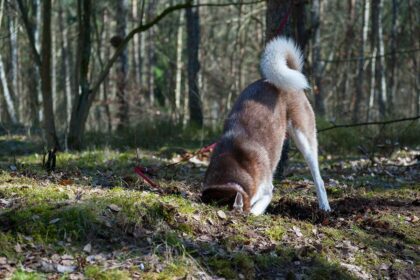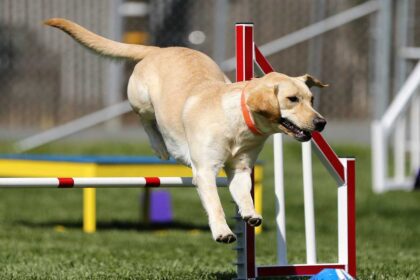In this in-depth exploration, we delve into the captivating world of Australian Shepherds, aiming to challenge and dispel the prevalent misconception surrounding their temperament. So lets know about are australian shepherds aggressive yes or no.
Despite the widely held belief that labels them as “aggressive”, we embark on a journey to uncover the truth about these intelligent and loyal companions.
Our mission is to not only confront the myth but also to foster responsible ownership and a deeper understanding of the breed, ultimately dismantling the undeserved stigma attached to Australian Shepherds.
History and Background of Australian Shepherds
The narrative of Australian Shepherds is a tapestry woven with threads of persistence and adaptability. Contrary to their name, they do not hail from Australia but originated in the Basque region of Europe.
These dogs accompanied shepherds who migrated to the United States in the 19th century, adapting rapidly to the challenges of the American West. Evolving into the quintessential working dogs, Australian Shepherds garnered a reputation for their versatility, intelligence, and unwavering loyalty.
These dogs excel not only in herding livestock but also in guarding and participating in dog sports. The amalgamation of their herding instincts and intelligence shaped their unique temperament characterized by high energy levels and an indomitable spirit.
Understanding the historical backdrop of Australian Shepherds allows us to appreciate their distinctive qualities, presenting them not merely as pets but as resilient allies in the symbiotic relationship between humans and their devoted canine companions.

Nature vs. Nurture: Factors Influencing Behavior
A. Genetic Predisposition of Australian Shepherd
The genetic makeup of Australian Shepherds is deeply rooted in their herding tendencies. This inherent skill, developed over generations, contributes to their defining qualities of intelligence, agility, and hard work.
However, misconceptions often cloud our understanding of these genetic predispositions. To unravel the true nature of Australian Shepherds, we must acknowledge and appreciate how their genetics shape their unique characteristics, dispelling false assumptions about their behavior.
B. The Impact of Childhood Influence, Instruction, and Socialization
Parenting, socialization, and training play pivotal roles in shaping the behavior of Australian Shepherds. Early socialization significantly influences their adaptability and sociability, making them well-rounded adult dogs.
Positive training methods capitalize on their natural intelligence and receptiveness, fostering a strong bond between owners and dogs. Addressing behavioral issues requires correct training, consistency, and positive reinforcement.
The triumvirate of upbringing, training, and socialization molds Australian Shepherds into desirable companions, underscoring the responsibility owners bear in nurturing a mutually understanding and inseparable bond with these clever and spirited canines.
Let’s see video: Correcting Aggressive Interaction With Australian Shepherd
Dispelling Aggression Myths: Debunking Misconceptions
A. Most Types of Misconceived Behavior
Australian Shepherds often fall victim to misunderstandings due to their distinctive characteristics. Vocalizations, such as barking, are subjective interpretations of excitement or alertness, wrongly perceived as aggression.
The herding instinct, a fundamental trait, is occasionally mistaken for aggression, highlighting the importance of awareness and education.
Traits associated with guarding, a natural inclination of the breed, may be misinterpreted as possessiveness.
Rectifying these misconceptions is crucial for gaining a deeper insight into the Australian Shepherd breed, fostering meaningful connections, and challenging erroneous beliefs about their behavior.
B. Aggression vs. Protective Behavior: Comprehend the Difference
Differentiating between aggression and protection is essential for understanding the nuances of Australian Shepherds’ behavior. Recognizing their innate guarding nature involves identifying subtle signs of a desire to protect their family.
This protective role can be positively guided through training and socialization, achieving a balanced perspective on protection.
Interactions with strangers and other animals may trigger protective instincts, but reinforcing the distinction between protection and aggression cultivates a well-rounded, socially sophisticated Australian Shepherd.
Awareness of this delicate yet crucial difference forms the foundation for achieving harmony with these profoundly loyal and naturally protective canine companions.

Responsible Ownership: Creating a Safe Environment
A. The Appropriate Amount of Mental and Physical Stimulation
Maintaining the health and well-being of Australian Shepherds requires a delicate balance of mental and physical stimulation. Regular exercise is imperative to manage their boundless energy and prevent behavioral problems stemming from boredom.
Interactive games and mental stimulation tactics not only keep them physically active but also challenge them intellectually. Engaging Australian Shepherds in various activities, including competitive training, contributes to their overall happiness and fulfillment.
Owners play a crucial role in caring for their pets’ physical and emotional needs, fostering a harmonious and healthy life.
B. Boundaries and Clear Communication
Establishing clear boundaries and effective communication is fundamental for a healthy relationship with Australian Shepherds. Consistent training and reinforcement communicate expectations clearly, creating a sense of safety for the dog.
Positive reinforcement-based obedience training not only improves the relationship between owner and pet but also conditions desirable behavior. Setting rules and restrictions serves as a guideline for a balanced dog, fostering respect and cooperation.
Regular communication of expectations through positive reinforcement creates a loving environment that enhances the well-being and behavior of Australian Shepherds.
Conclusion
In conclusion, this article offers a comprehensive and nuanced perspective on Australian Shepherds, aiming to dispel falsehoods and reveal their true essence. We explored their historical roots, genetic predispositions, and the profound impact of upbringing and training on their behavior.
Importantly, we addressed common misinterpretations, distinguishing between protective instincts and aggression.
It is crucial to acknowledge that Australian Shepherds are not inherently aggressive but, through their intelligence, loyalty, and strong work ethic, develop unique temperaments.
Responsible ownership involves understanding their specific needs, providing ample mental and physical exercise, and communicating through positive reinforcement.
As advocates for these remarkable canines, our call to action is clear: challenge stereotypes and educate others. Through thorough clarification, we contribute to dispelling false beliefs and creating a community that respects Australian Shepherds as spirited, loving pets not for aggressive.













